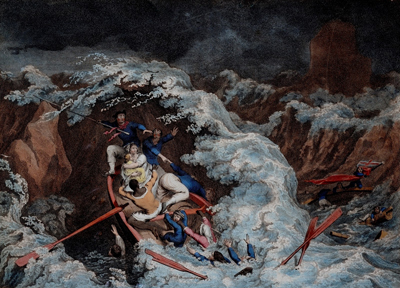The Nancy Packet
In the last half of 1783, Gillray began another attempt to become a "serious" artist/engraver. He had already established himself as a leading creator of satiric prints in 1782, producing approximately 50 prints in that year for as many as nine different publishers. But he no doubt craved the greater status, recognition, and commensurate income that could be gained as a stipple engraver.
In 1784, then, we see the fruit of that effort in several large-scale prints, including one on the wreck of the packet ship, Nancy, which was lost off the Scilly Isles in February of 1784. Shipwrecks were of course favorite subject for serious artists at the time, providing drama in the life and death struggle against the seas, a range of attitudes and expressions among the victims, as well as a variety of line, texture, and light to show off one's print-making skills. But what made this shipwreck particularly compelling was its most famous passenger, Ann Cargill (nee Brown).

Ann Cargill was a young and beautiful actress/opera singer. The daughter of a coal merchant, she had made her London debut in the role of Titania in Thomas Arne's The Fairy Prince in 1771. And while still a teenager, she had performed in leading roles in a number of plays and operas, including (ironically enough) The Tempest. By 1779 and 1780, she was supposedly the highest paid actress in Britain.
But she was also famous for a very public "private" life that included disputes with her father, contract violations, and multiple affairs and lovers. It was one such affair that took her to India to perform before the British enclaves there. Showered with jewels and gifts and rich beyond her wildest dreams, she was returning to England with a child and her latest lover, Captain John Haldane when the ship was overtaken by a huge storm and foundered upon the rocks of the Scilly Islands. Ann was then about 23 or 24 years old.
What we see in Gillray's print, then, is Ann and her child in one of the smaller lifeboats as it abandoned the sinking Nancy and sought the shore of Rosevear Island. Ann is portrayed as the heroine of a sentimental drama, holding her child, madonna-like, in the midst of the chaos. All around her are sailors trying vainly to grab drowning stragglers or hold on to the oars as the stern of the boat is overwhelmed and sinks into the sea. Ann's gaze is directed toward the looming cliffs or possibly to her doomed lover as he holds onto the last of the mast with its British flag.
At 43.2 x 54.5 centimeters The Nancy Packet was the largest print Gillray had ever produced and an impressive display of Gillray's printmaking abilities. It is also, however, completely in keeping with the prevailing tastes of English history painting which whether produced by Gillray, Barry, or Northcote today seems forced, exaggerated, and histrionic. Gillray no doubt improved his craft in attempts like these, but it was in his satiric prints that he was truly orginal.
Sources and Reading
- "A Scandalous Star," BBC Cornwall History
- The Nancy Packet & the Wheels Wreck, ScillyDivers Blogspot.
Comments & Corrections
NOTE: Comments and/or corrections are always appreciated. To make that easier, I have included a form below that you can use. I promise never to share any of the info provided without your express permission.